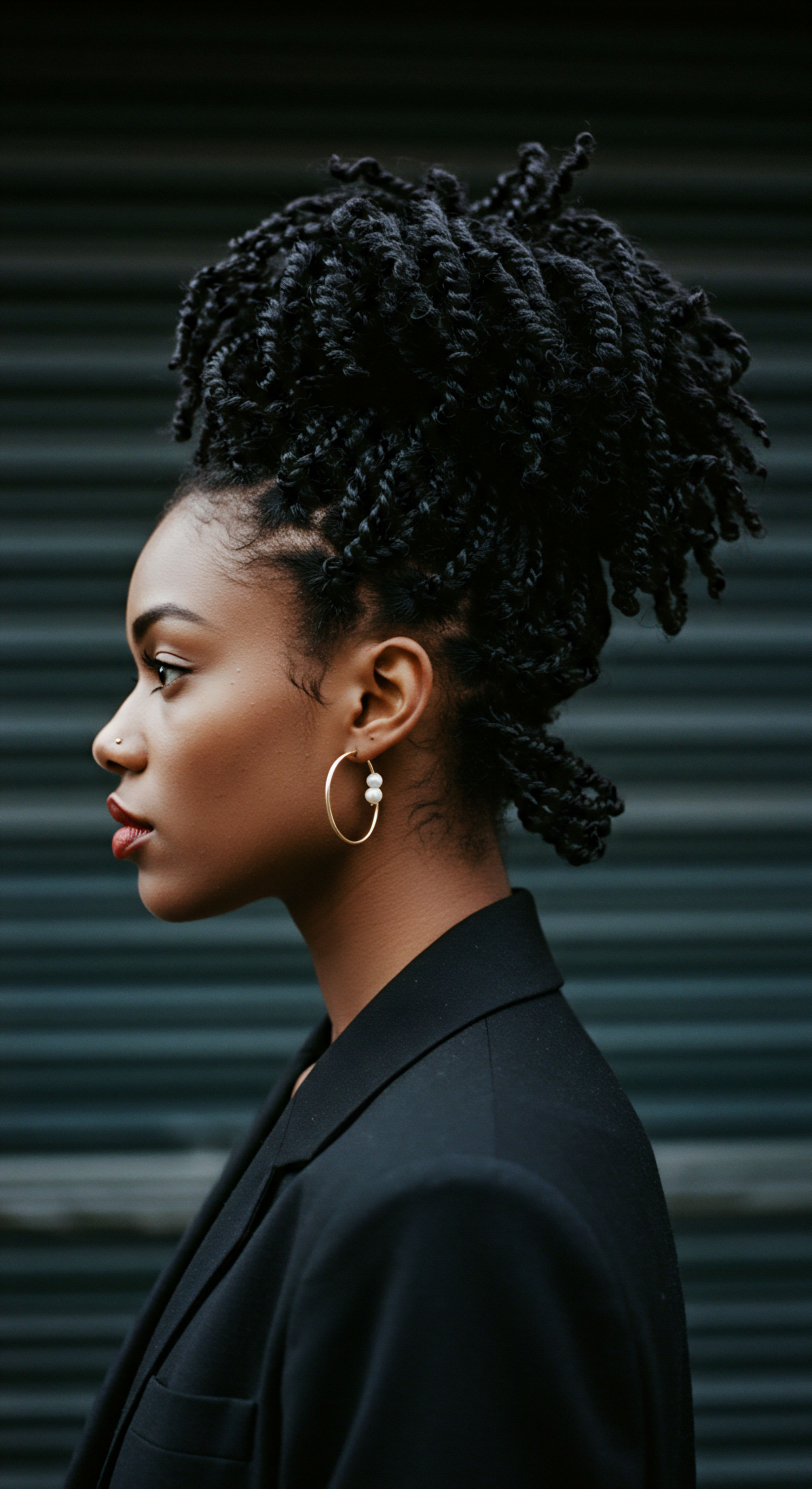
Roots
The very strands that crown us, particularly those with the intricate coils and textures that grace Black and mixed-race hair, hold stories as old as time. They are not merely protein filaments; they are conduits of heritage, expressions of identity, and delicate wonders of natural design. Understanding their intrinsic nature, their foundational architecture, is the first step on a thoughtful journey toward truly supporting their vitality and encouraging their magnificent growth. To consider length retention for textured hair demands a deeper gaze into its fundamental composition, a gentle inquiry into the whispers of its very being.
Each hair strand, regardless of its outward appearance, begins its life within the scalp, a testament to the body’s ceaseless generative power. For textured hair, this genesis point often sets the stage for a unique journey. The hair follicle, a tiny organ beneath the skin, shapes the strand as it emerges.
Unlike straight hair, which typically grows in a round cross-section from a relatively straight follicle, textured hair often originates from an oval or even flat follicle, dictating its characteristic curl pattern. This distinctive shape means the hair shaft itself is not uniformly round but can possess varying thicknesses and curvatures along its length.
Understanding the unique architecture of textured hair, from its follicular origin to its spiraling structure, is fundamental to nurturing its growth and preserving its delicate integrity.
The outer layer of each hair strand, the cuticle, acts as its protective shield. Picture it as a series of overlapping scales, much like shingles on a roof. In straight hair, these scales lie relatively flat. With textured hair, however, the very curves and twists of the strand cause these cuticle scales to be naturally more raised, or at least more prone to lifting, especially at the points where the strand bends and turns.
This inherent characteristic renders textured hair more susceptible to external friction and environmental aggressors. The open nature of these cuticles also means moisture, a lifeblood for healthy hair, can escape more readily, contributing to dryness and, subsequently, brittleness.
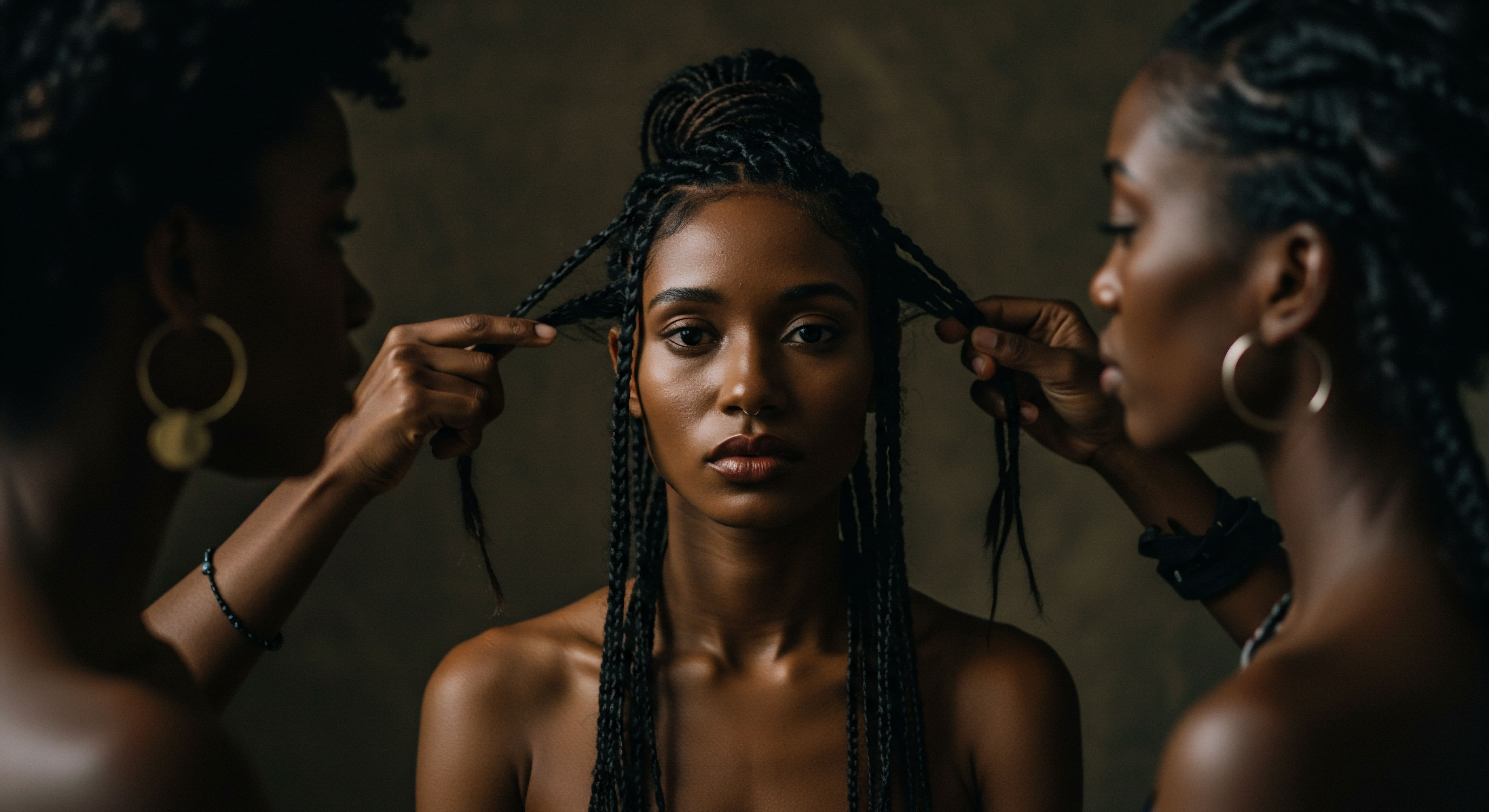
The Architecture of Textured Hair
To truly appreciate the needs of textured hair, one must comprehend its microscopic landscape. The internal structure, or cortex, composed of keratin proteins, is responsible for the hair’s strength and elasticity. For highly textured hair, the distribution of these proteins, along with melanin granules that provide color, can be less uniform, contributing to areas of inherent weakness.
These variations, though subtle, mean that the hair’s tensile strength, its ability to withstand pulling forces, can differ along a single strand. This microscopic reality informs every aspect of its care.
- Hair Follicle Shape ❉ Often oval or flat, shaping the distinctive curl.
- Cuticle Layer ❉ Naturally more raised or prone to lifting at curves, inviting moisture loss and friction.
- Cortex Composition ❉ Can exhibit less uniform protein distribution, creating potential areas of fragility.
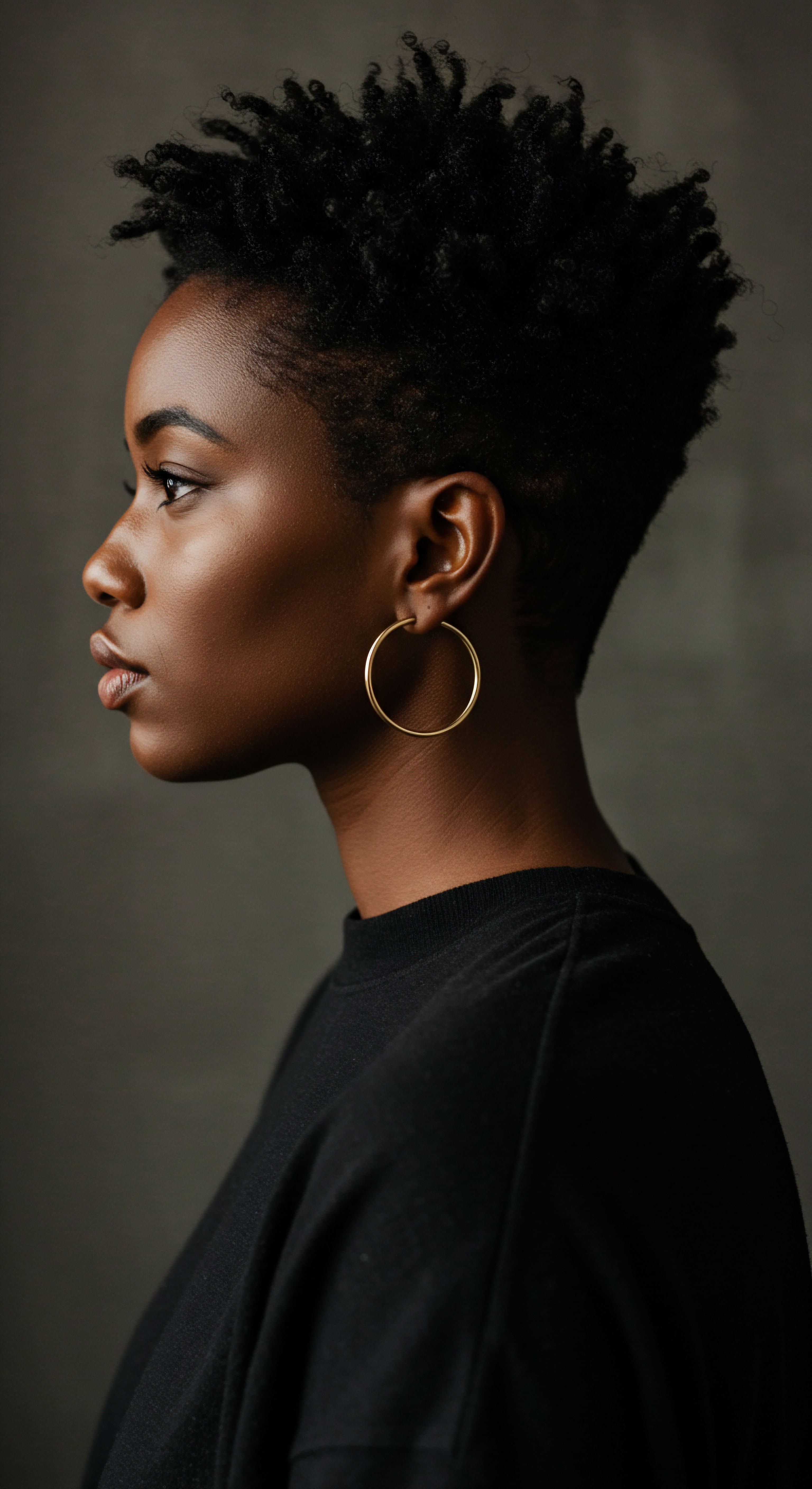
What are the Unique Vulnerabilities of Coiled Strands?
The helical nature of textured hair presents distinct vulnerabilities. Each twist and turn represents a potential point of stress, a bend in the road where the strand is less resilient. Consider the cumulative effect of these turns ❉ they create more surface area for adjacent strands to interact, increasing the likelihood of tangling and knotting. This entanglement, when coupled with external forces such as abrasive fabrics or vigorous manipulation, leads to friction.
Friction, in turn, causes the already raised cuticle scales to lift further, chip, or even break away, exposing the vulnerable inner cortex. This cycle of damage impedes length retention, as the hair breaks off before it can truly show its growth.
The natural growth cycle of hair, while universal, takes on particular significance for textured strands. Hair grows in phases ❉ anagen (growth), catagen (transition), and telogen (resting). While bonnets do not directly influence the biological machinery of hair growth within the follicle, they profoundly impact the hair’s ability to survive the rigors of daily life, particularly during the critical anagen phase when strands are actively lengthening. By mitigating external stressors, a bonnet acts as a silent guardian, allowing hair to progress through its natural cycle with minimal interruption from environmental and mechanical damage.
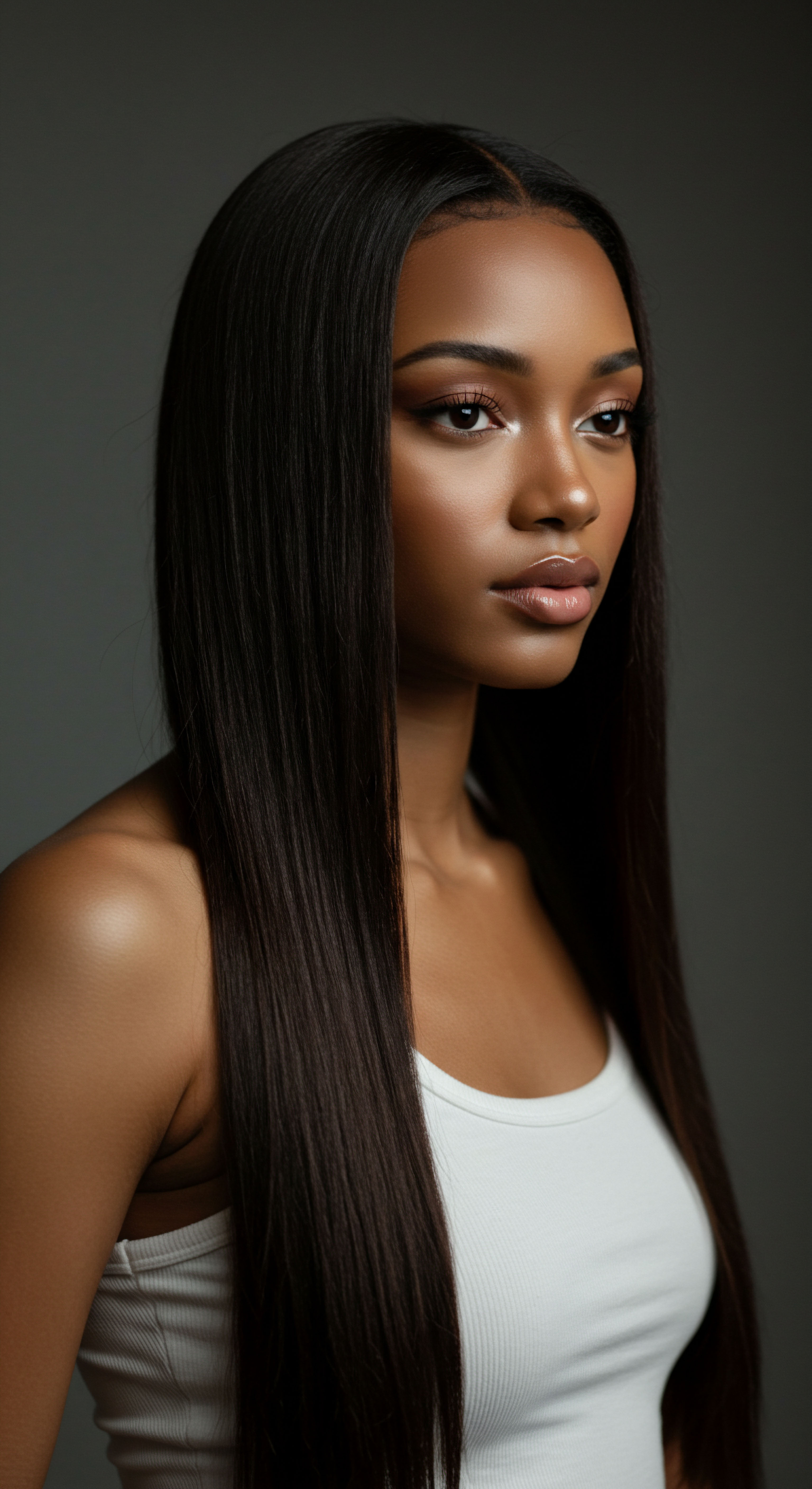
Ritual
Stepping from the foundational understanding of textured hair’s innate characteristics, we turn now to the deliberate, gentle practices that nurture its wellbeing. Our daily and nightly actions, often subtle and repetitive, collectively shape the destiny of our strands. It is within these routines, these tender rituals, that we find opportunities to protect and preserve the delicate structure of textured hair. The wisdom lies not in grand gestures, but in consistent, thoughtful attention, especially as our hair rests against surfaces for hours each night.
The concept of protective styling is deeply rooted in the history of textured hair care, born from an intuitive understanding of its fragility. These styles, whether braids, twists, or buns, aim to minimize manipulation, reduce exposure to environmental elements, and shield the vulnerable ends of the hair. While styling choices play a significant daytime role, the nighttime hours present a unique challenge and an unparalleled opportunity for protection. Sleep, a period of restorative rest for the body, can ironically become a time of considerable stress for textured hair, as it rubs against pillows and bedding.
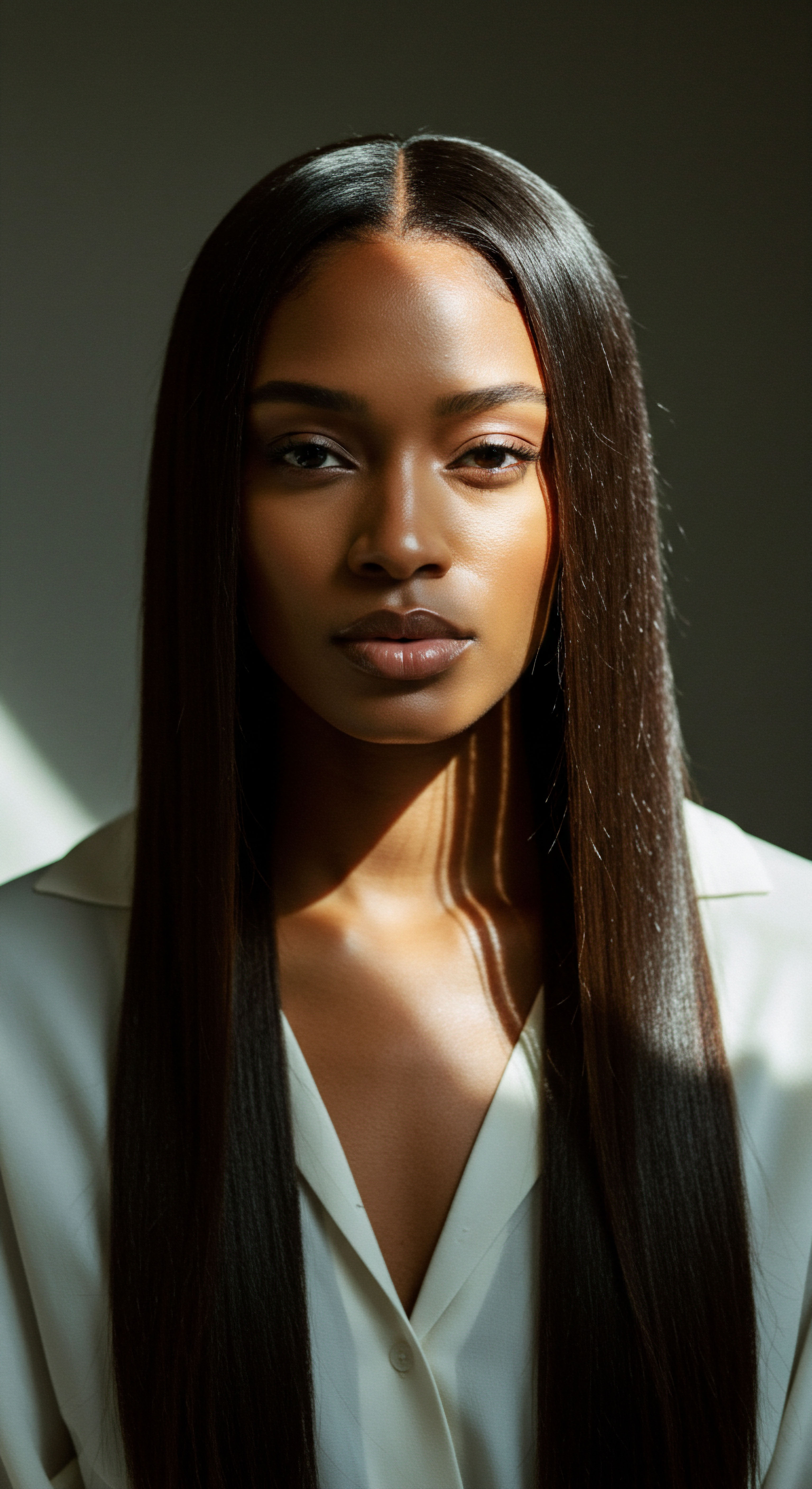
Safeguarding Strands Through Sleep
The surfaces our hair encounters during sleep wield considerable power over its condition. Traditional cotton pillowcases, though seemingly soft, possess a microscopic roughness. Their fibers create friction against the hair shaft, particularly for coiled and kinky textures where the cuticle is already predisposed to lifting.
This constant rubbing can lead to tangling, frizz, and, most critically, cuticle abrasion and breakage. The very act of turning and shifting during sleep can unravel delicate curl patterns and compromise the integrity of the hair’s outer layer.
Consider the quiet battle waged each night between hair and fabric. The delicate strands, with their naturally raised cuticles, are dragged across cotton fibers, causing microscopic tears and lifting. Over time, these seemingly minor interactions accumulate, leading to visible damage, split ends, and a noticeable reduction in retained length. The hair may be growing from the scalp, but if the ends are breaking off at a similar rate, the appearance of growth is diminished.

How do Nighttime Habits Shape Hair Health?
Nighttime habits extend beyond simply lying down. The way hair is gathered or left loose, the temperature of the sleeping environment, and even the products applied before bed all play a part. Yet, the choice of a sleeping surface remains paramount. A cotton pillowcase, while comfortable for the skin, acts as a moisture thief for hair, drawing out essential hydration.
This desiccation makes hair even more brittle and prone to breakage from friction. The goal of any effective nighttime ritual for textured hair is to minimize friction and preserve moisture.
This is where the wisdom of a silk bonnet finds its place within the ritual. It is not merely an accessory; it is a conscious choice, a gentle barrier. By encasing the hair within its smooth confines, a silk bonnet provides a sanctuary from the abrasive forces of bedding.
The hair glides effortlessly against the silk, rather than catching and tearing on rougher fibers. This reduced friction is the cornerstone of its protective prowess, allowing hair to maintain its structure and moisture content throughout the night.
| Surface Material Cotton |
| Fiber Texture Rough, Absorbent |
| Moisture Absorption High |
| Friction Potential for Hair High (causes snagging, breakage) |
| Surface Material Satin (Polyester) |
| Fiber Texture Smooth, Less Absorbent |
| Moisture Absorption Moderate |
| Friction Potential for Hair Low (reduced snagging) |
| Surface Material Silk |
| Fiber Texture Very Smooth, Non-Absorbent |
| Moisture Absorption Low |
| Friction Potential for Hair Very Low (hair glides freely) |
| Surface Material Silk offers the lowest friction and moisture absorption, providing superior hair protection during sleep. |
The embrace of a silk bonnet transforms the nighttime experience from a potential source of damage into a period of genuine restoration. It is a simple yet profound adjustment to the daily ritual, one that acknowledges the delicate nature of textured hair and honors its need for consistent, gentle care. This shift in practice contributes significantly to a visible difference in hair health and, critically, its ability to retain length over time.

Relay
Moving beyond the foundational characteristics and the daily practices, we now consider the deeper interplay of science, culture, and material properties that converge around the simple silk bonnet. This exploration delves into the precise mechanisms by which such a seemingly modest item contributes to the grand aspiration of length retention for textured hair. It is here that we connect the visible outcome of longer, healthier strands to the microscopic dance of friction and hydration, understanding how a deliberate choice can profoundly influence hair’s resilience.
The promise of length retention is often misconstrued as an acceleration of hair growth. In reality, hair growth rates are largely genetically determined, typically averaging around half an inch per month for most individuals, regardless of hair type. The true challenge for textured hair lies not in its ability to grow, but in its propensity to break. Every strand that grows from the scalp must survive the journey to its full potential length.
For textured hair, this journey is fraught with obstacles ❉ tangling, environmental exposure, and, most significantly, mechanical abrasion. A silk bonnet does not make hair grow faster; it allows the hair that is growing to remain attached, preventing premature breakage.

The Science of Surface Interaction and Hair Integrity
The key to a silk bonnet’s efficacy lies in the unique properties of silk fibers. Unlike cotton, which has a relatively rough, short-staple fiber structure that creates significant friction and can snag hair, silk boasts incredibly long, smooth protein fibers. This smoothness minimizes the coefficient of friction between the hair and the bonnet fabric.
When hair glides effortlessly across a silk surface, the cuticle scales remain undisturbed, lying flat and cohesive. This preservation of the cuticle is paramount, as a healthy, intact cuticle layer is the primary defense against moisture loss and internal damage.
Research into the tribological properties of hair, the study of friction and wear on hair, provides compelling insights. One area of scientific inquiry highlights how the cumulative micro-abrasions from nightly contact with high-friction surfaces, even seemingly soft cotton, contribute significantly to cuticle lift and subsequent breakage. Specifically, the continuous, low-level mechanical stress experienced by hair during sleep on abrasive surfaces can lead to a phenomenon known as Fatigue Damage.
This progressive degradation, though individually imperceptible, culminates in weakened strands and ultimately, fracture. For example, a study examining the mechanical properties of hair under repeated stress demonstrated that even slight increases in friction over prolonged periods dramatically reduced the hair’s resistance to fracture, illustrating the cumulative impact of nightly abrasion on overall hair integrity.
A silk bonnet supports length retention not by accelerating growth, but by drastically reducing the mechanical damage that causes textured hair to break prematurely.

How Does Silk Preserve Hair’s Moisture Balance?
Beyond friction, silk’s non-absorbent nature plays a critical role in moisture preservation. Cotton is highly hydrophilic, meaning it readily absorbs water. This property, while beneficial for towels, becomes detrimental for hair. A cotton pillowcase or scarf will draw moisture directly from the hair shaft, leaving strands dry, brittle, and even more vulnerable to breakage.
Silk, conversely, is hydrophobic, meaning it repels water. It allows the hair to retain its natural oils and any applied moisture treatments, ensuring strands remain hydrated and supple throughout the night. This sustained hydration is a silent hero in the fight for length retention, as well-moisturized hair is inherently more elastic and less prone to snapping.
The impact extends to the very formation of curl patterns. When hair is allowed to move freely without friction, its natural coils and kinks are preserved. This means less tangling upon waking, which translates to less manipulation and pulling during the detangling process.
Each time hair is detangled, there is a risk of breakage, particularly for textured hair that is prone to forming single-strand knots. By minimizing tangles overnight, a silk bonnet reduces the need for aggressive detangling, thus safeguarding length.
Culturally, the practice of covering hair at night has existed across many communities for centuries, often predating modern scientific understanding. From head wraps in African traditions to elaborate nightcaps in European history, the intuitive wisdom of protecting hair during sleep has been a consistent thread. The modern silk bonnet is a continuation of this legacy, marrying ancestral practice with contemporary material science to offer an optimized solution for textured hair care. It represents a conscious choice to honor the hair’s inherent delicacy and support its natural inclination towards vitality.
The consistent use of a silk bonnet becomes a powerful ally in the pursuit of length retention. It is a proactive measure, a preventative shield against the unseen forces of friction and dehydration that silently erode hair integrity each night. By creating an optimal sleeping environment for textured hair, the bonnet allows the strands to truly flourish, revealing their true potential for growth and health.

Reflection
As we conclude our exploration, the silk bonnet stands not as a fleeting trend, but as a testament to the enduring wisdom of gentle care for textured hair. Its efficacy, grounded in both the scientific principles of reduced friction and moisture preservation, and the intuitive practices passed down through generations, offers a profound answer to the quiet query of length retention. This journey has illuminated how seemingly small, consistent acts of kindness towards our strands can lead to magnificent, visible transformations. It is a reminder that genuine vitality stems from understanding, respect, and the purposeful creation of an environment where our hair can simply be, grow, and truly shine.

References
- Davies, C. J. L. Bushby, R. J. Smith, A. M. Webster, J. R. P. & Whittington, A. J. S. (2017). Friction and wear properties of human hair. Journal of Cosmetic Science, 68(1), 1–12.
- Robbins, C. R. (2012). Chemical and Physical Behavior of Human Hair (5th ed.). Springer.
- Goeckeler, S. (2016). Hair Care ❉ An Illustrated Dermatologic Approach. Thieme.
- Bolton, L. (2007). Hair ❉ Its Structure and Function. CRC Press.
- Bhushan, B. (2013). Introduction to Tribology (2nd ed.). Wiley.
- Kelly, R. E. & Price, D. (2000). Hair Science ❉ An Introduction. Royal Society of Chemistry.
- Sakamoto, K. & Maibach, H. I. (2018). Hair and Hair Care (2nd ed.). CRC Press.
- Van der Hoeven, P. C. J. & de Klerk, A. E. A. E. (1989). The friction of human hair. Journal of Cosmetic Science, 40(6), 335–346.